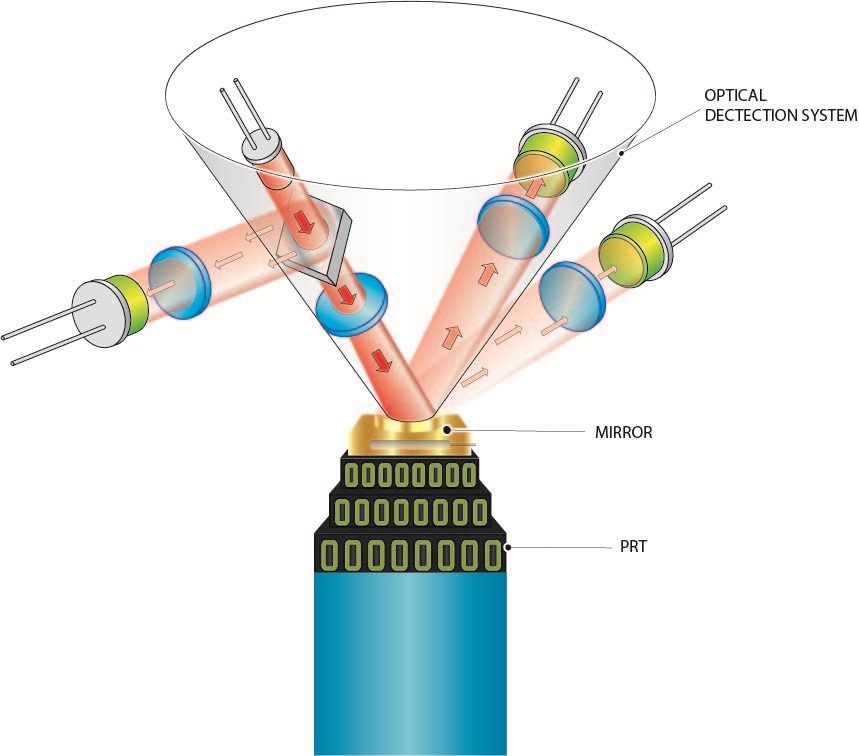Stage 1 – The challenge
A chilled mirror hygrometer is an essential reference instrument for trace moisture and humidity calibrations. It directly measures the formation of condensation on a mirrored surface. Ensuring that the formation of the condensate is as repeatable as it can be is the basis for how the measurement is made.
Without external cooling, the current dry end specification for chilled mirror hygrometers is 90 °C frost point, which is equivalent to approximately 95 ppb. The challenge was to extend this capability to -100 °C frost point, or around 14 ppb.
Chilled mirror hygrometers that offer this capability do exist, however they rely on external cooling which makes them bulky. Extending the bottom range of internally cooled chilled mirror hygrometers allows the bottom end capability of National Metrology Institutes and other accredited laboratories around the world to move beyond the -90 °C frost point limit helping the community as a whole take the next step in terms of repeatable, reproducible measurements at the extremes of the dew point/frost point range.
Without external cooling, the chilled mirror hygrometer was capable of cooling sufficiently to achieve a stable condensate layer at -100 °C. What our engineers need to explore further were:
The temperature measurement at the point at which the condensate layer and the amount of water in the flow path when in equilibrium was key. They knew that they needed to look at the PRT (platinum resistance thermistor) making that measurement itself and what improvements could be made to it and its installation.
From previous attempts to solve the problem, the engineers knew that the current unit would measure down to the required level. In fact, a unit had previously been calibrated at -100 °Cdp by NPL which highlighted some of the repeatability issues that needed to be solved. There was a strong correlation between the measured value and the sample flow rate.
Despite the challenges, solving the problem of extending the dry end specification of the chilled mirror was essential. It would not only allow them to extend their UKAS accreditation down to the -100 °C frost point level, but would directly benefit customers with improved dry-end performance of their calibrated instruments.
Stage 2 – The Prototype
As a first stage, we developed a prototype chilled-mirror hygrometer, based on the previous design but with an updated measuring head and gas flow path to ensure the formation of the condensate was as repeatable as possible. Previous testing at NPL, using the Measurement for Recovery funding, helped with this evolution in the design.
The dry-end specification of the prototype chilled mirror was -100 °C frost point (approximately 14 ppb). With the available cooling capacity, they had the possibility of a stable condensate layer at -100 °C.
Although we were testing the prototypes at our Ely manufacturing facility, we wanted to involve the NPL Humidity Measurement and Standards Group. NPL’s expertise provided the final information needed regarding the updated measuring head design.
With NPL’s involvement and the use of their facilities, knowledge and equipment, our developers were able to validate the design without needing to involve a third party as a beta testing site.
As product manager Richard Gee, explained, ‘We did not believe we could carry out the work necessary in time to give us the confidence in our redesign to launch the product in its current iteration. With the help of NPL, we reduced the time to market by at least three months.’
Why measuring low dew points accurately is important
Chilled mirror hygrometers are used as references in commercial laboratories for trace moisture and dew point calibrations of many instruments and sensors, such as dew-point transmitters. Improving the dry end specification of this reference will ensure extra reliability for these calibrated instruments at their lower measurement ranges.
How a chilled mirror sensor works
Chilled-mirror dew-point hygrometers are precision instruments for critical measurement and control applications. Chilled mirror sensors measure a primary characteristic of moisture – the temperature at which condensation forms on a surface. This means that chilled mirror instruments are inherently repeatable, giving reliable results every time.
The chilled mirror sensor consists of a temperature-controlled mirror and an advanced optical detection system. A gas sample is passed into the sensor housing and flows over the surface of the chilled mirror contained within. At a temperature dependent upon the moisture content in the gas, and the operating pressure, the moisture in the gas condenses out on the surface of the mirror. An optical system is used to detect the point at which this occurs, and this information is used to control the mirror temperature and maintain a constant thickness of the condensation layer on the mirror surface.
At an equilibrium point, where the evaporation rate and condensation rate on the surface of the mirror are equal, the mirror temperature represents the dew point.

Caption: ‘Simplified diagram shows the key elements of a chilled mirror sensor’
Have a question? Get in touch!
Our team of application specialists will be happy to discuss your specific application. Use this form to contact us.Related Products
High-Precision Chilled Mirror Hygrometer
Michell S8000 RS
High Precision Chilled Mirror Hygrometer – Michell S8000 -100
Want to see more information like this?
Sign up to one of our Industry newsletters and you’ll receive our most-recent related news and insights all directly to your inbox!
Sign Up